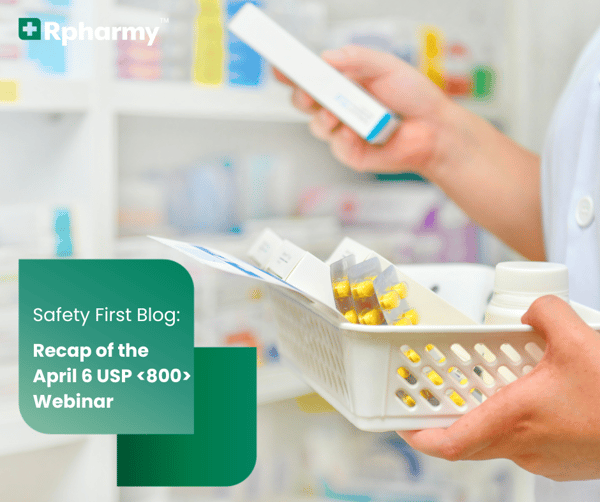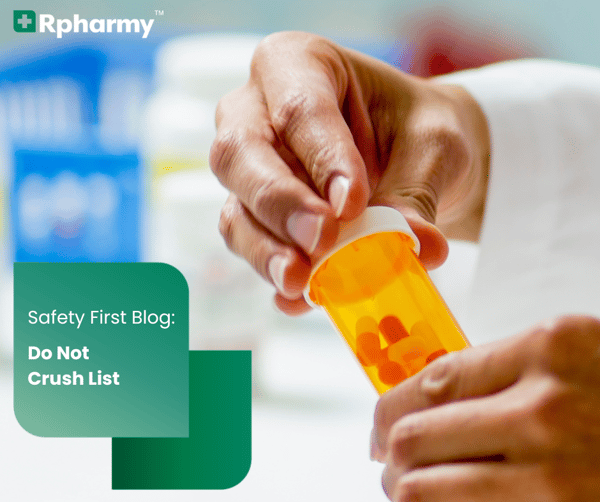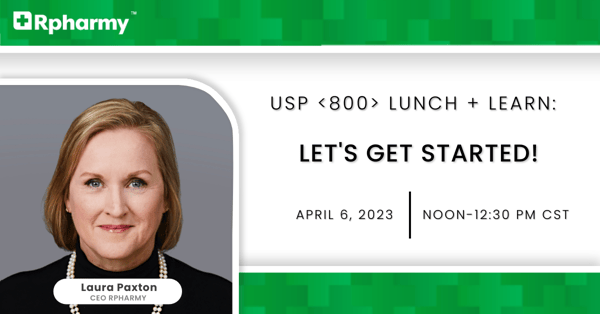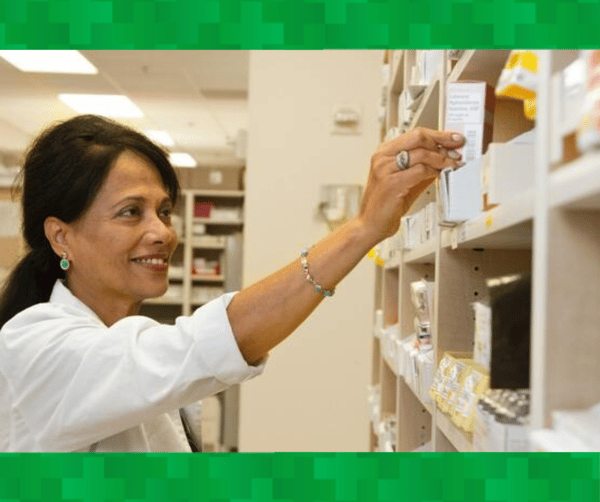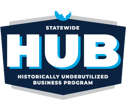Following are the questions posed and answers given by Rpharmy's Customer Experience Specialist Sherlene Christen on the April 13th USP <800> Lunch + Learn.
Recap: USP <800> Preparedness Lunch + Learn, Session 1
USP <800>. November 1, 2023. Are you panicking yet?
If you are, you are not alone. The hurry up and wait is over, and now it’s time to finish up any final updates and changes your healthcare organization needs to make before the Nov. 1, 2023 UPS <800> deadline.
On April 6, we kicked off a webinar series designed to offer you the information and support you need to ensure your organization is ready for the Joint Commission, States Board of Pharmacy or other agencies that will be evaluating your USP <800> readiness. These events create a space for conversation and community among pharmacists and healthcare leaders.
Who is Rpharmy?
Rpharmy came to be after the founders suffered a personal loss due to a medical error and vowed to do what they could to help prevent other families from going through the same tragedy. While implementing Formweb, their medication safety solution, Rpharmy began to get requests from hospitals for ways to more easily and effectively document and share hazardous drug safety information across their organization.
As is often the case, necessity is the mother of invention. Rhazdrugs was developed and is now helping many hospitals prevent dangerous exposure to hazardous drugs and also meet USP <800> safety information documentation and communication requirements.
In fact, while speaking to hospitals, we’ve seen that most underestimate how many healthcare workers are exposed to hazardous drugs each year. If you didn’t know, it’s 8 million, according to the CDC.
Also, 70% plan to take more than a year to fully comply with USP <800>.
First shared in 2003, the ISMP’s (Institute for Safe Medication Practices) list of Do Not Crush Medications has been relied upon by healthcare facilities across the U.S. However, as of Nov. 17, 2022, the ISMP does not maintain or share this list on its website.
Following are the questions posed and answers given by Rpharmy's Customer Experience Specialist Sherlene Christen on the April 6th USP <800> Lunch + Learn.
One observation I’ve made over the years is how isolated and siloed hospital pharmacists and pharmacy directors can be. While pharmacists are some of the hardest-working and most brilliant healthcare workers, they do not have the opportunities other healthcare professionals have to consult and share with other pharmacists. Many pharmacists are head down, working to manage a busy hospital pharmacy and provide medications to people who need them.
In conversations with more than 100 hospitals and systems, we’ve seen two common types of consolidations from the perspective of the formulary. The acquiring systems usually go one of two ways with their formulary:
- System-wide formulary that all facilities access
- System-wide formulary that each facility pulls from to create its own formulary
In the previous Safety First Blog, I explained the logistics, benefits and challenges of merging into a single system-wide formulary. In this blog, I’ll outline the second most common route taken when consolidating formularies.
WHERE ROUTE 2 GOES
In this situation, the healthcare system manages an umbrella formulary with assessed and approved drugs. The facilities or markets within that system then each have a formulary based on the umbrella formulary. For instance, a system may include a market that specializes in cardiology and another that specializes in trauma, and of course, each formulary looks quite different. However, if a trauma hospital cares for a patient who is also receiving cardiology treatment, the patient’s required medications are easily accessed thanks to the system-wide formulary and connection to the cardiology hospital’s formulary.
In formulary management software, each facility, whether it be a children’s hospital or an oncology facility, can see which drugs are approved in the system-wide formulary within the formulary management dashboard, and the individual facilities where that drug is already approved are also identified.
Also, each drug monograph should show what restrictions apply to the selected drug, including Service Line, Formulary Location, Service Population, Prior Authorization Required, Restrictions, and more. All facilities can also access medication safety information and see if the drug is High Alert, has Black Box Warnings, LASA, etc.
WHY IT WORKS
Similar to the overarching system-wide formulary, this arrangement provides previously standalone facilities with negotiating power, medical coding, medication options, compounding opportunities, and even a greater sense of community gained by being part of a larger organization.
However, in this system, the markets also have the autonomy that an overarching system-wide formulary does not provide its facilities, which many facilities prefer after operating independently. On the other hand, their pharmacy directors maintain the formulary and also benefit from the system’s added support of centralized drug approval and all the safety information and resource materials through their EHR or formulary management system.
WHAT ISSUES MAY COME UP
Because each market manages its own formulary, more resources may be required at each facility to assess inventory and request drugs to be assessed by the Health System Pharmacy and Therapeutics Committee. The system itself may need to mediate when a market requests access to a new drug, and the umbrella formulary may be larger than that of a system that maintains one formulary for the entire system.
FINAL THOUGHT
Managing the consolidation or acquisition of a hospital is a massive project with many moving pieces - one of which is the formulary. Because the formulary plays a central role in patient care & safety, the speed and the way in which it is organized is vital. However, each of these methods has unique benefits and challenges.
UP NEXT
Register today for the first USP <800> Preparedness Lunch + Learn on April 6, and mark your calendar to spend upcoming lunches with Rpharmy. We’re here to support you in this critical effort to improve your organization's health and well-being, and we hope to see you soon.
In the meantime, check out our Safety First Blog for the USP <800> information and resources you need.
We’ve helped many healthcare systems and hospitals of all sizes work through the USP <800> hazardous drugs safety requirements, and we are now sharing all that we know with you in the USP <800> Preparedness Lunch + Learn webinar series. In each session, we’ll cover a specific requirement and challenge, leaving plenty of time for questions and discussion so you can walk away with the information and tools you need to prepare for USP <800> inspections.
New USP <800> Updates Coming!
As if preparing for USP <800> wasn’t already stressful, we’re expecting USP <800> updates on April 5. Don’t worry! Rpharmy’s CEO Laura Paxton and Rpharmy’s USP <800> Subject Matter Expert, Sherlene Christen, will fill you in on all you need to know about the updates when we kick off the Lunch + Learn series on April 6.
The free, 30-minute webinars will run through May and will cover:
- Assessments of Risk
- Drug assessment
- Common gaps in USP <800> compliance
- Communicating safety policies across your facility or system in the Electronic Health Record
- Preparing for inspectors
- How to truly protect healthcare workers from hazardous drug exposure
In the meantime, check out our Safety First Blog for the USP <800> information and resources you need.
In the next two Safety First blogs, I’ll discuss two of the common types of consolidations from the perspective of the formulary. In both cases, a larger hospital or established health system acquires smaller regional or rural hospitals or even a specific healthcare facility, i.e. chemotherapy treatment, cardiac care, ER, etc. While consolidation can be challenging on all levels, when it comes to formulary, consolidation provides regional hospitals and facilities with more resources regarding negotiating power, medical coding, medication options, compounding opportunities, and even a greater sense of community gained by being part of a larger organization.
The acquiring systems usually go one of two ways with their formulary:
- System-wide formulary that all facilities access
- System-wide formulary that each facility pulls from to create its own formulary
Regional hospitals or local facilities can access drugs they do not regularly stock through their parent health systems. For example, a hospital admits an elderly woman from a local nursing home who is on drug treatment for Parkinson’s. The hospital needs access to that drug during the patient’s stay but does not regularly stock it. Instead of purchasing a full bottle of 100 pills, they can request the amount of medicine the patient needs from the medical center.
Because the Health System Pharmaceutical and Therapeutics Committee has already vetted and negotiated all the medications within the larger formulary, smaller or regional facilities can gain access to any medication they may need but do not keep in stock quickly and easily. The upfront work of researching needed drugs and negotiating their price has been done for the smaller facility creating efficiency and also cost savings.
The system-wide formulary also provides all the safety information and resource materials through their EHR or formulary management system. Each drug monograph should show what restrictions apply to the selected drug, including Service Line, Formulary Location, Service Population, Prior Authorization Required, Restrictions, and more. All facilities can also access medication safety information and see if the drug is High Alert, has Black Box Warnings, LASA, etc.
While consolidation offers many benefits to smaller facilities and their patients, we know it is not ever easy. As we work with healthcare systems that are strategically acquiring regional hospitals, we’ve helped them through the lengthy and complicated consolidation process that involves technology, property and equipment, and also the more complicated human aspect.
When it comes to the formulary, the Rpharmy team can help make the process of combining formularies or giving formulary access to a new facility easier. Our Safety First Blog also has more resources as you plan a formulary merger.
Stay tuned for the next Safety First blog where I’ll talk through health systems that maintain specific formularies for each system facility.
With the continued trend of hospital consolidation, the modern formulary is now going system-wide. In upcoming Safety First Blogs, I'll share more information on the benefits of merging individual formularies into one system-wide database, even when it's a mammoth job. In the meantime, here's a look at a still-relevant blog about where formulary has been and where it's going.
A hospital’s formulary initially consisted of a simple book of medications approved for patient use in that particular organization. When hospitals made their formulary available online in the late 1990s, it was basically the same book, but now on a computer screen.
Protect Healthcare Workers: Document Safe Handling Info for ALL Drugs
The mission of USP <800> is to “protect healthcare workers from unintentional exposure to drugs that are hazardous.” And the extensive list of guidelines and requirements covers a lot of ground, but should your healthcare system go further to fully protect your personnel from the harmful and sometimes deadly effects of hazardous drug exposure?
Despite USP <800>’s focus on hazardous drug exposure prevention, there are several potential areas for exposure not covered in guidelines. With more than 8 million healthcare workers exposed to hazardous drugs each year, according to the CDC, the more layers of protection and prevention healthcare systems provide, the better the outcome for such a substantial group of people.
Be prepared to document handling instructions for ALL drugs - whether they are formulary or not. While creating a formal Assessment of Risk (AoR) for every drug is not a USP <800> requirement, certainly assessing each drug's hazardous potential and providing handling guidelines for everyone that may come in contact with that drug is. If you see that the potential for risk is minimal at your facility, then consider a formal AoR, which allows you to create specific handling guidelines for that drug based on your assessment. These steps will ensure that your health system meets the USP <800> requirements and can significantly improve the safety and well-being of healthcare workers by communicating risks and handling information for all drugs.
Are you referencing the NIOSH 2016 or NIOSH 2020 list of hazardous drugs? Both lists are still acceptable by inspectors but do either list fully cover the hazardous drugs in your healthcare system? The FDA list of newly approved drugs grows each month, but NIOSH doesn’t stay up-to-date with all the latest. Even then, not all new drugs may be classified as “hazardous” while still proving dangerous to healthcare workers. It is on you to thoroughly examine the drugs used within your system and whether or not they are categorized by NIOSH as such.
Drugs don’t always enter a healthcare system through the expected route of receiving in the system’s clinical pharmacy. When they enter your facility, many patients bring outside medications such as estrogen supplements and even investigational drugs that aren't yet FDA-approved. These situations can expose clinicians and nurses to drugs they don’t typically interact with. These drugs aren’t even typically listed within the formulary so how do you handle these situations?
One final possible gap in your safe handling instruction communication is disposal information. USP <800> doesn’t require the documentation and communication of disposal safety information, leaving that up to the EPA and other federal, local and state regulations; however, waste removal is a potential area for hazardous drug exposure. By including this information, you’ve gone another extra step to ensure the safety and well-being of all healthcare workers in your facility.
How do you best communicate safety information to everyone who is potentially exposed to hazardous drugs? Many rely on spreadsheets housed on the intranet, which are both tedious to maintain and access. Still, others haven’t even reached the digital age and document hazardous drug handling information in physical binders.
If the USP <800> requirements are already overwhelming, number 1, you’re not alone, but also there is a better way. A cloud-based platform accessible by all healthcare workers where and when they work with hazardous drugs. By communicating through both text and visuals, these solutions also go the extra step towards true healthcare worker safety.
If you’d like to know more about Rpharmy’s Rhazdrugs hazardous drugs safety platform, check out this quick video.

